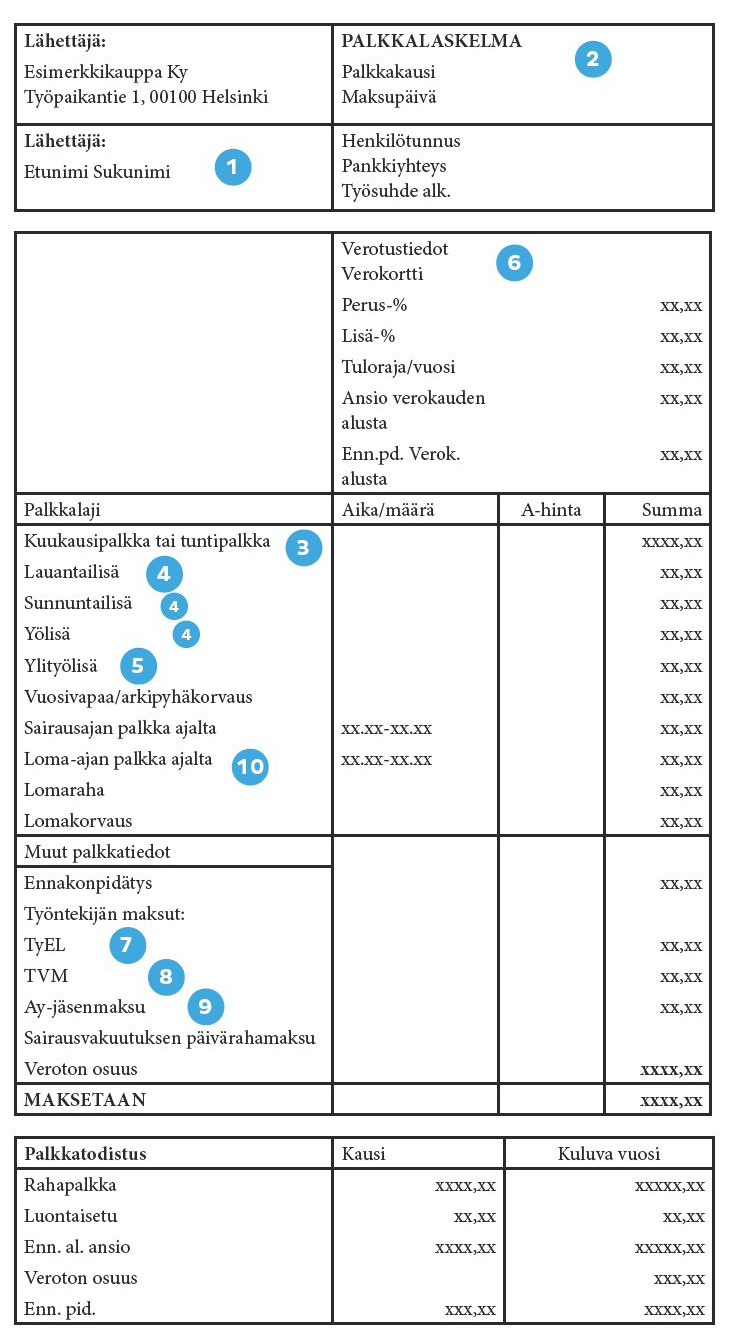Pay (wages and salaries)
Updated: 20.09.2022
‘Pay’ – i.e. a wage or salary – is the remuneration paid by an employer to an employee for work done.
How is pay determined?
Pay and earnings in statistics
Was your pay calculated correctly?
How to interpret your payslip
How is pay determined?
The worker and the employer agree on pay and other terms and conditions of employment when they conclude an employment contract. This should be done in writing.
There is no law in Finland to determine the amount of pay. Minimum pay levels for different sectors are specified in collective agreements signed between a trade union (such as PAM) and an employer organisation. An employer and an employee may not agree on pay falling below these minimum levels in an employment contract. Conversely, they are always allowed to agree on better pay.
Pay can be divided into basic pay and various allowances (also called supplements or bonuses). Basic pay can be monthly, hourly or piecework pay. Allowances can be made up of compensation for overtime or working in the evenings or on public holidays, for example. Allowances vary between different sectors. To find out what you ought to be paid, you should always check the collective agreement in place in your own sector.
You can also check the minimum pay levels for the commercial and hotel and restaurant sectors through here (in Finnish).
Pay and earnings in statistics
There is a difference between ‘pay’ – i.e. ‘wages and salaries’ – and ‘earnings’ in statistics. What is it? That’s explained by PAM Economist Antti Koskela in the video clip below.
Wages and salaries only refer to basic pay. Earnings, in turn, also include commissions and allowances based on special conditions and working hours, but not overtime. As a result, earnings are often higher than basic pay.
In colloquial language, pay and earnings are often used synonymously, but there is in fact a difference. This is important to know when comparing income levels in different sectors based on statistics.
Was your pay calculated correctly?
Sometimes the amount that you are paid does not add up to what you are owed. Therefore, it is important to keep track of your pay and working hours. Ask for all pay-related discussions to be conducted in writing. This makes it easier to prove what was agreed.
1. Keep a record of your hours
Write down the hours that you have worked on a printed calendar, for example. If required, you can use it as evidence even years later.
2. Always check your payslip
Your employer is required to provide you with a payslip every pay day. Check it and compare it to your own record of hours worked. Do the hours that you worked add up? Did you also receive all of the allowances due to you? Keep your payslips safe.
3. Ask your employer to correct the issue
If you were not paid what was due or if you notice errors or omissions, contact your employer right away and try to sort things out. In most cases, such issues are caused by human error, and it only takes a reminder to correct them.
4. Seek help if necessary.
If you are uncertain about your issue, check with your workplace shop steward. If there is no shop steward at your workplace, contact your union.
If the issue is not resolved after you have sent a reminder, your shop steward or union can help and take the issue forward. Don’t hesitate to contact us.
In extreme cases, a shop steward or a union has helped an employee recover pay claims amounting to thousands of euros, such as unpaid working hours allowances.
How to interpret your payslip
Every time employees are paid wages, they must get a payslip. A payslip shows what your wages are, any supplements, the taxes withheld from the wages, and other payments.
Payslips can look different from one employer to another, but must contain the same information. A payslip can be on paper or in electronic form.
If you have difficulties understanding the payslip you got from your employer, don’t hesitate to ask your supervisor for help in reading it.

1. Contact details
Make sure your personal details and bank account are up to date.
2. Wage payment period
The wage payment period means the wages for the work done in that time period.
3. Wages
Basic wages can be paid on a monthly, hourly or piecework basis. Minimum wages for service sectors are agreed in the collective agreements made by PAM and the employers’ federations. Employees and employers cannot agree an employment contract with wages below these minimum wages. Higher wages can always be agreed, however. Check the collective agreement for your sector at: pam.fi/en/work/collective-agreement
4. Working hours supplements
Various supplements are a key element of wages. You can get supplements for evening work or work done on a Saturday, Sunday or public holiday or overtime, for example. Supplements are different in different sectors. The time when entitlement to evening, Saturday or overtime supplements starts also varies. Check the collective agreement for your sector to see what has been agreed on supplements and what basis they are paid on.
5. Overtime
The overtime you have worked must be shown on your payslip. In many sectors wages increased by 50% are paid for work done beyond an average of 37.5–40 hours a week. There are different rules on overtime in different collective agreements. Check the collective agreement for your sector to see what the agreement is on overtime and how it is paid. Additional hours and overtime must always be agreed between the employer and the employee.
6. Taxes
Your payslip will show the details of your tax card. The same tax card is used for both main and secondary jobs and there is just one income limit for the year on the card. If your income has changed or if you are likely to exceed the income limit, it is advisable to update the income details on your tax card and send it to your employer in good time.
7. Earnings-related pension contributions (TyEL)
Statutory earnings-related pension contributions are deducted based on the wages paid to employees. In private and public sectors, pension contributions are paid jointly by employees and employers. In 2022 the pension contribution for private-sector employees under the Employees Pensions Act is on average 24.85% of employees’ wages. Of this, the share paid by employees aged under 53 and 63 or more is 7.15%, and for those aged between 53 and 62 it is 8.65%. The employer’s share is on average 17.40%.
8. Unemployment insurance contribution (TVM, työttömyysvakuutusmaksu)
Statutory unemployment insurance contributions are paid by all employers and by wage earners aged between 18 and 64. Unemployment insurance contributions fund unemployment benefits including earnings-related allowances paid by unemployment funds as well as basic unemployment allowance and labour market subsidy paid by Kela. In 2022 wage earners’ unemployment insurance contribution is 1.50% of wages.
9. Trade union membership fees (Ay-jäsenmaksu)
If you have made a collection agreement with your employer, PAM membership fees of 1.5% are automatically deducted from your wages. A collection agreement applies to one employer only. If you have more than one employer, you need to make separate collection agreements with each one.Union membership fees are fully tax-deductible.
10. Holiday pay, holiday bonus and holiday compensation
If you are on annual holiday during a wage period, holiday pay must be shown on your payslip. Your employer must also give you a separate annual holiday pay slip stating the amount of holiday pay (lomapalkka) or holiday compensation (lomakorvaus) and the basis on which it was determined.
Holiday bonus (lomaraha) is agreed in the collective agreement, and when an employee takes holiday it is 50% of annual holiday pay. In short employment relationships and in part-time work, possibly for several employers, employees don’t always manage to take their annual holiday during the employment relationship, so it is paid as holiday compensation. At the end of the employment relationship, holiday that has been earned but not taken is also paid as holiday compen


